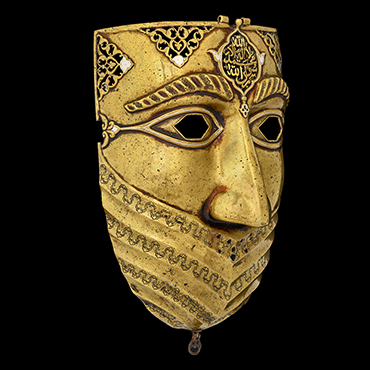The face of a warrior
Inscribed
لا إله إلا الله محمد رسول الله
There is no god but Allah, Muhammad is the Messenger of Allah
This is a very rare, possibly unique, example of a brass war mask. While unsuitable for combat—since brass is heavier and softer than the steel used for most war masks—it was likely intended for parades where the warm, golden brass, highlighted with silver, would have made a spectacular impression. The face is highly stylized, with a series of ridges over the mouth area, pierced for breathing. The eyebrows are rendered in the same way, alternating plain and decorated diagonal grooves, while the eyeholes are crafted as six-sided openings with heavy rims. The stylistic elements of these grooved sections closely resemble those found on large Safavid brass vessels, particularly columnar torch stands, such as the massive example displayed in the nearby Furusiyya Collection. The mask was originally attached to a helmet by the hinge at the top.
The shahadah is inscribed at the center of the forehead. This clear declaration of faith would not only demonstrate piety and instill courage in the wearer, but could also be perceived as providing spiritual protection.
Masked helmets were used in what is now the Islamic world by both Persian and Roman armies in the pre-Islamic period. They appear in pre-Mongol painting and in manuscripts depicting warriors from after the Mongol invasion of the early 7th century AH/13th century CE. However, fewer than ten authentic examples have survived to the present day.
The face of a warrior
War mask
Iran, late 10th century AH/16th century CE
Brass, silver, h. 23.4 × w. 15.6 × d. 9 cm
Furusiyya Art Foundation, R-747

